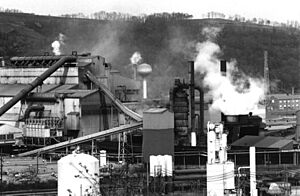Edgar Thomson Steel Works facts for kids
The Edgar Thomson Steel Works is a huge steel mill located near Pittsburgh, Pennsylvania, in the towns of Braddock and North Braddock. It has been making steel since 1872. Today, it's owned by U.S. Steel and is officially known as the Mon Valley Works – Edgar Thomson Plant.
Contents
History of the Steel Works
The Edgar Thomson Steel Works was built on a historic spot called Braddock's Field. This area is right next to the Monongahela River, which was great for moving materials like coke, iron, and finished steel by boat.
Long ago, in 1755, a big battle happened here during the French and Indian War. Later, in 1794, it was also where farmers and soldiers gathered during the Whiskey Rebellion before marching on Pittsburgh.
How Steel Was Made: The Bessemer Process
The Edgar Thomson Steel Works was built because of a new invention called the Bessemer process. This was the first cheap way to make a lot of steel. In this process, hot air was blown through melted iron. This air removed impurities, making the iron into strong steel. This happened inside a large, egg-shaped container called a Bessemer converter.
Building the Mill
In 1872, Andrew Carnegie learned about the Bessemer process while in Europe. He decided to build his own steel plant in Pittsburgh. He teamed up with several partners, and their company was called Carnegie, McCandless, and Company.
The plant was named after J. Edgar Thomson, who was the president of the Pennsylvania Railroad. Later, in the early 1880s, Andrew Carnegie combined his steel businesses into a larger company called Carnegie Brothers and Company. This included the Edgar Thomson Steel Works and other important places like:
- Sciota Ore Mines (where they got iron ore)
- Union Iron Mills
- Lucy Furnaces
- Monastery Coke Works
- Larimer Coke Works
By bringing all these parts together, the new company became very powerful.
First Steel and Growth
Construction on the Edgar Thomson Steel Works began on January 1, 1873. It cost about $1.2 million to build. The mill was designed by Alexander Lyman Holley, and a skilled manager named Captain Bill Jones was hired to run it.
On August 22, 1875, the giant Bessemer converter at the Edgar Thomson Steel Works made its first batch of liquid steel. This steel was used to make 2,000 steel rails for the Pennsylvania Railroad. In just one year, the mill produced over 32,000 tons of steel rails! Captain Jones proudly described the mill as "the most powerful rail mill in the country." With constant improvements, the mill could soon make 225 tons of steel rails every day. By the late 1880s, James Gayley became the plant manager.
The Homestead Strike
In 1892, workers at the Edgar Thomson plant joined one of the biggest strikes in U.S. history, known as the Homestead Strike. This happened when Henry Clay Frick, a partner of Carnegie, tried to cut the workers' wages.
Steelworkers at the Edgar Thomson Works and other mills stopped working to support their fellow workers. Frick took strong action. He brought in thousands of new workers and hired 300 Pinkerton guards to protect them. A fight broke out, and some people were killed or injured. To stop the violence, the governor, Robert E. Pattison, sent in soldiers. After the strike, the company started operations again with new workers who were not part of a union.
Becoming Part of U.S. Steel
In 1901, Andrew Carnegie sold his company, Carnegie Steel Company, which included the Edgar Thomson Works. It was bought by J. P. Morgan, Elbert H. Gary, and other investors. This sale helped create U.S. Steel, one of the biggest steel companies in the world.
During the steel industry crisis in the 1980s, many famous steel plants closed down. However, the Edgar Thomson plant survived. It became the last major steel mill in the Mon Valley, an area that once had 90,000 people working in the steel industry.
Current Operations
Today, the Edgar Thomson Steel Works is still an important part of U.S. Steel. It uses two large blast furnaces (Furnaces No. 1 and No. 3) to make steel. In 2005, the mill produced 2.8 million tons of steel, which was a big part of U.S. Steel's total production in the country. About 900 people work at the mill, and some families have worked there for many generations.
Modern Improvements
The mill has made many improvements over the years. In 1992, a $250 million "continuous caster" was installed. This machine turns liquid steel directly into slabs, making the process faster and more efficient.
In April 1995, the mill was recognized as a historic landmark by ASM International, a group that honors important engineering achievements. Other famous structures honored by this group include the Statue of Liberty and the Eiffel Tower.
On May 2, 2019, U.S. Steel announced a huge investment of over $1 billion for the Mon Valley Works. This money will be used to add new technology at the Thomson Plant that combines thin slab casting and hot rolling into one continuous process. This will make the Mon Valley Works the first facility in the United States to use this advanced technology.
Images for kids
-
A Bessemer converter blowing a heat of steel






